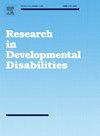与正常发育的同龄人相比,有学习障碍的儿童的主动控制对记忆的增强作用较小
IF 2.6
2区 医学
Q1 EDUCATION, SPECIAL
引用次数: 0
摘要
主动控制学习有助于优化记忆表现,这在成年人中得到了广泛的观察。最近,有研究表明,这种效应在典型发育(TD)儿童中随着年龄的增长而发展。然而,目前还没有研究直接比较学习障碍儿童和学习障碍儿童的主动控制效应。这项研究是第一个使用严格的实验范式来检验这些效应如何在两组中表现出来的研究。方法本研究采用主动学习范式,TD儿童(N = 51,28名女性/ 23名男性,8-11岁,M = 116.52个月,SD = 9.60个月)和LD儿童(N = 48,27名女性/ 21名男性,8-11岁,M = 116.52个月,SD = 10.68个月)在两种条件下学习对象:主动条件下,儿童决定学习的顺序和节奏;被动条件下,儿童按照预定的学习顺序学习。结果两组患者的主动控制效果均随年龄增长而增强。然而,与TD儿童相比,LD儿童表现出较小且较晚的增强效应。结论主动控制对LD患儿的整体增强作用较小,且效果显现较TD患儿晚。这些发现首次提供了发育方面的证据,证明LD和TD儿童在积极控制方面的益处存在差异。有需要的儿童,应采取相应的教育措施。本文章由计算机程序翻译,如有差异,请以英文原文为准。
Active control enhances memory less in children with learning disabilities compared to their typically developing peers
Background
Active control over study, which helps to optimize memory performance, has been widely observed in adults. Recently, it has been revealed that this effect develops with age in typically developing (TD) children. However, no prior studies have directly compared active control effects between children with learning disabilities (LD) and their TD peers. This study is the first to examine how these effects manifest in both groups using the rigorous experimental paradigm.
Methods
In this study, an active learning paradigm was adopted in which TD (N = 51, 28 female/ 23 male, 8–11 years, M = 116.52 months, SD = 9.60 months) and LD children (N = 48, 27 female/ 21 male, 8–11 years, M = 116.52 months, SD = 10.68 months) studied objects under two conditions: an active condition, where children decided the order and pacing of study, and a passive condition, where they followed a predetermined study sequence.
Results
It was found that active control effect increased with age in both groups. However, children with LD showed a smaller and later enhancement effect compared to their TD peers.
Conclusion
Children with LD experienced a smaller overall enhancement from active control, and the effect emerged later compared to their TD peers. These findings provide the first developmental evidence of differences in the benefits of active control between LD and TD children. Corresponding educational practices should be tailored to children with LD.
求助全文
通过发布文献求助,成功后即可免费获取论文全文。
去求助
来源期刊

Research in Developmental Disabilities
Multiple-
CiteScore
5.50
自引率
6.50%
发文量
178
期刊介绍:
Research In Developmental Disabilities is aimed at publishing original research of an interdisciplinary nature that has a direct bearing on the remediation of problems associated with developmental disabilities. Manuscripts will be solicited throughout the world. Articles will be primarily empirical studies, although an occasional position paper or review will be accepted. The aim of the journal will be to publish articles on all aspects of research with the developmentally disabled, with any methodologically sound approach being acceptable.
 求助内容:
求助内容: 应助结果提醒方式:
应助结果提醒方式:


